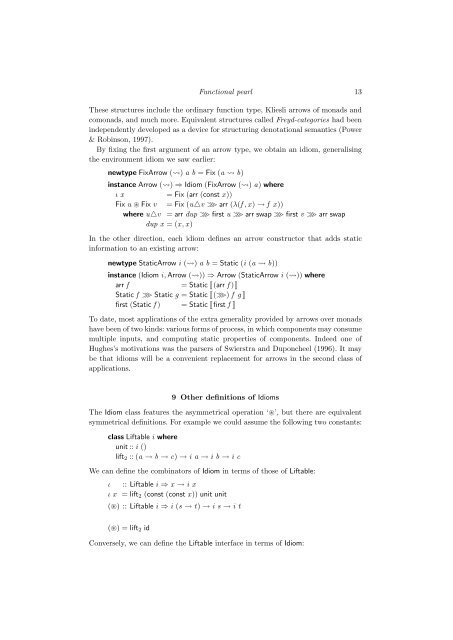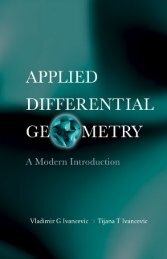Idiom
Idiom
Idiom
Create successful ePaper yourself
Turn your PDF publications into a flip-book with our unique Google optimized e-Paper software.
Functional pearl 13<br />
These structures include the ordinary function type, Kliesli arrows of monads and<br />
comonads, and much more. Equivalent structures called Freyd-categories had been<br />
independently developed as a device for structuring denotational semantics (Power<br />
& Robinson, 1997).<br />
By fixing the first argument of an arrow type, we obtain an idiom, generalising<br />
the environment idiom we saw earlier:<br />
newtype FixArrow () a b = Fix (a b)<br />
instance Arrow () ⇒ <strong>Idiom</strong> (FixArrow () a) where<br />
ι x = Fix (arr (const x))<br />
Fix u ⊛ Fix v = Fix (u△v ≫ arr (λ(f , x) → f x))<br />
where u△v = arr dup ≫ first u ≫ arr swap ≫ first v ≫ arr swap<br />
dup x = (x, x)<br />
In the other direction, each idiom defines an arrow constructor that adds static<br />
information to an existing arrow:<br />
newtype StaticArrow i () a b = Static (i (a b))<br />
instance (<strong>Idiom</strong> i, Arrow ()) ⇒ Arrow (StaticArrow i ()) where<br />
arr f = Static (arr f )<br />
Static f ≫ Static g = Static (≫) f g <br />
first (Static f ) = Static first f <br />
To date, most applications of the extra generality provided by arrows over monads<br />
have been of two kinds: various forms of process, in which components may consume<br />
multiple inputs, and computing static properties of components. Indeed one of<br />
Hughes’s motivations was the parsers of Swierstra and Duponcheel (1996). It may<br />
be that idioms will be a convenient replacement for arrows in the second class of<br />
applications.<br />
9 Other definitions of <strong>Idiom</strong>s<br />
The <strong>Idiom</strong> class features the asymmetrical operation ‘⊛’, but there are equivalent<br />
symmetrical definitions. For example we could assume the following two constants:<br />
class Liftable i where<br />
unit :: i ()<br />
lift2 :: (a → b → c) → i a → i b → i c<br />
We can define the combinators of <strong>Idiom</strong> in terms of those of Liftable:<br />
ι :: Liftable i ⇒ x → i x<br />
ι x = lift2 (const (const x)) unit unit<br />
(⊛) :: Liftable i ⇒ i (s → t) → i s → i t<br />
(⊛) = lift2 id<br />
Conversely, we can define the Liftable interface in terms of <strong>Idiom</strong>:














